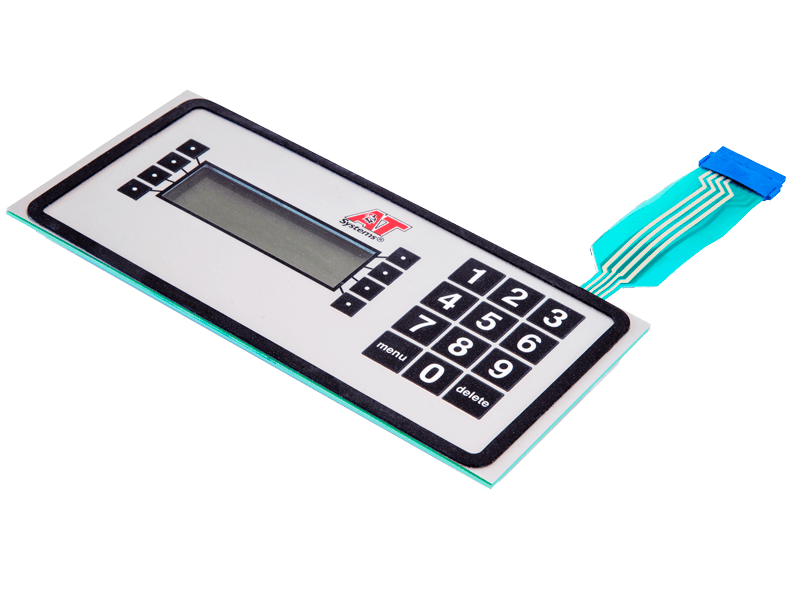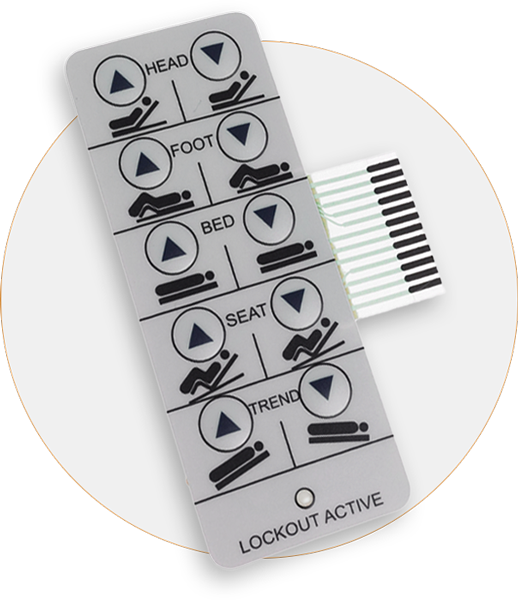Everything About Membrane Layer Switch Over: Comprehending Its Layout and Performance
When you think of the control interfaces in modern-day tools, membrane buttons usually come to mind. These components are more than simply buttons; they mix design and functionality perfectly. Recognizing how they function and what makes them effective can alter your viewpoint on everyday electronics. But, there are subtleties to their style and performance that you may not be conscious of. Allow's explore what sets membrane switches in addition to other control systems.
What Are Membrane Buttons?

Their seamless nature makes them easy to clean and immune to dirt and dampness, a vital attribute in numerous environments. Membrane layer switches can also be customized concerning shape, dimension, and graphics, enabling makers to produce special interfaces tailored to specific items. Plus, they're lightweight and thin, which aids in decreasing the general bulk of devices. Overall, membrane buttons play a substantial duty in boosting user experience across a broad array of applications.
Exactly How Membrane Switches Over Job
When you press a trick on a membrane button, it turns on an uncomplicated yet efficient mechanism. The leading layer, frequently constructed from versatile material, presses down onto a conductive layer beneath it. This activity bridges the gap in between conductive traces, completing an electric circuit. As soon as the circuit shuts, it sends a signal to the tool's controller, which translates your input.
You'll discover that the tactile comments differs based upon the switch style, providing either a soft click or a more noticable reaction. Once you launch the secret, the membrane layer returns to its initial position, resuming the circuit and quiting the signal. This process occurs practically immediately, making certain a responsive individual experience.
Membrane layer switches are prominent as a result of their toughness and resistance to dust and dampness, making them optimal for numerous applications, from family devices to clinical devices. Understanding this procedure aids you value their widespread use.
Key Components of Membrane Switches
Recognizing the essential components of membrane switches is fundamental for comprehending their performance and style. At the core, you'll locate the graphic overlay, which supplies the aesthetic interface for customers. Underneath that, there's a spacer layer that separates the circuit layers, guaranteeing that they do not make call up until pushed. The circuit layer is where the magic happens; it includes conductive traces that complete the circuit when you push the button. One more essential element is the adhesive backing, allowing the switch to follow surface areas firmly. The protective layer guards against ecological variables and use, prolonging the button's life-span. Each element plays a considerable role in ensuring reputable performance and individual interaction. By recognizing these parts, you'll acquire insight into just how membrane layer changes operate and their value in numerous applications.
Products Used in Membrane Layer Switch Layout
The performance and resilience of membrane switches over greatly depend upon the products used in their style. You usually encounter polyester and polycarbonate as primary substratums as a result of their outstanding strength and adaptability. These materials stand up to scratches and chemicals, making them optimal for demanding environments.
The conductive layers often use silver or carbon, picked for their reliability and conductivity. membrane switch manufacturer. Silver supplies superior performance, while carbon is a cost-effective option. For the overlay, you could consider a matte or shiny surface, relying on your visual needs and user experience
Adhesives play an essential function as well; they bond layers safely and assure long life. Ensure to choose adhesives that stand up to ecological factors like temperature and moisture. Do not overlook the value of a great printing method for graphics, as it improves both performance and visual charm. Picking the appropriate products will certainly ensure your membrane layer button stands the examination of time.
Layout Factors To Consider for Membrane Layer Buttons
While creating membrane layer buttons, it's crucial to take right into account different elements that affect their capability and individual experience. Start by concentrating on the format and switch dimension; ensure they're user-friendly and easy to browse. Take into consideration the responsive comments you intend to give-- will individuals need a visible click or a softer touch? Additionally, think of the materials you'll utilize, as they'll affect durability and visual appeals.
Confirm your design accommodates environmental factors, like moisture or temperature level variants, which can affect efficiency. By meticulously thinking about these elements, you'll create a membrane layer switch that boosts usability and fulfillment.
Applications of Membrane Switches
Membrane switches are view it versatile components located in numerous applications, from commercial devices to consumer electronic devices. You'll see their influence in equipments that need long lasting interfaces and in devices that take advantage of streamlined styles. Comprehending these applications helps you value the performance and functionality of membrane buttons in daily technology.
Industrial Devices Use
When you're wanting to enhance the capability of industrial equipment, membrane layer switches offer a trustworthy solution that integrates sturdiness with easy to use layout. These buttons are excellent for rough settings, offering resistance to dirt, wetness, and chemicals. You'll locate them in control panels for producing equipments, cooling and heating systems, and medical devices, where accuracy and responsiveness are crucial. Their reduced account means they fit effortlessly into different equipment, conserving important space while preserving convenience of use. With personalized graphics and backlighting alternatives, you can develop an intuitive user interface for drivers, enhancing effectiveness and safety and security. Plus, their lengthy life-span decreases upkeep costs, making them a clever investment for your industrial applications. Accept membrane switches to streamline your operations and boost total performance.
Consumer Electronics Combination
In the domain name of consumer electronics, membrane switches play an essential duty in boosting customer communication and gadget performance. Membrane layer buttons likewise guarantee resilience and resistance to dirt and wetness, expanding the life expectancy of your electronics. By selecting membrane buttons, you enhance not just the capability however additionally the style of your devices, making day-to-day communications smooth and delightful.
Advantages and Drawbacks of Membrane Layer Buttons
While membrane layer buttons offer a range of advantages, they additionally come with some drawbacks that you must take into consideration. One significant advantage is their small style, making them optimal for space-constrained applications.

However, there are disadvantages. Membrane switches can have a shorter life expectancy compared to mechanical switches, especially under heavy use. They can also be less tactile, which might affect individual responses throughout procedure. If damaged, repairing them can be challenging and usually calls for total replacement. Ultimately, their level of sensitivity to severe temperatures and environmental conditions may limit their efficiency in specific settings. Stabilizing these advantages and disadvantages will aid you determine if membrane layer buttons are the ideal fit for your task.
Regularly Asked Concerns
How Lengthy Do Membrane Layer Switches Usually Last?
Membrane switches over normally last between 5 to one decade, depending upon use and ecological conditions. You'll want to evaluate aspects like wear, exposure to wetness, and temperature changes to determine their durability efficiently.
Can Membrane Layer Switches Be Personalized for Particular Layouts?
Yes, you can personalize membrane click here for info layer switches to fit certain designs (membrane switch manufacturer). You'll have the flexibility to select colors, shapes, and formats that match your project's demands, guaranteeing they blend web effortlessly with your total aesthetic
What Is the Expense Variety for Membrane Change Production?
The price array for membrane button production commonly drops between $1 and $10 per device, depending on elements like style intricacy, quantity, and materials. You can obtain quotes from suppliers to find the very best alternative.

Are Membrane Switches Water Resistant or Resistant?
Membrane switches can be created to be waterproof or resistant, depending on materials utilized and construction approaches. If you require them for wet environments, ensure you define those needs throughout the layout procedure.
Just How Do Membrane Layer Switches Compare to Standard Switches?
Membrane switches are normally thinner and a lot more adaptable than typical buttons, supplying a smooth layout. They're frequently simpler to clean and integrate, but could not offer the tactile feedback you're used to with mechanical options.
Conclusion
